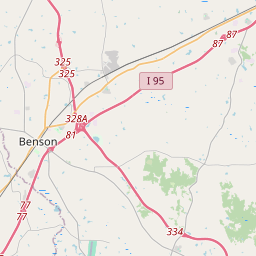The Battle Shifts East: Fighting on March 21
Historical marker location:
Four Oaks, North Carolina
( Memorial is on Bentonville Road, 0.4 miles north of Harper House Road (Route 1008), on the right when traveling north.)







© OpenStreetMap contributors
Loading...
Searching for other points of interest within 3 miles of this location.The first English child born in the New World, Virginia Dare, was born in what is now Roanoke Island, North Carolina, in 1587.
About Johnston County
Johnston County Timeline
Johnston County, located in northeastern North Carolina, has a rich and diverse history that dates back thousands of years. The earliest recorded human inhabitants in the area were indigenous tribes such as the Tuscarora and the Saponi. These tribes lived off the land and engaged in agriculture, hunting, and trading.
In the 18th century, European settlers began to make their way into the region. Johnston County was officially formed in 1746, named after Gabriel Johnston, the colonial governor of North Carolina at the time. The county quickly grew with the arrival of more settlers, mainly from Scotland, Ireland, and England. The economy of the county saw an expansion with the establishment of farms, sawmills, and gristmills, as well as the production of naval stores.
During the American Revolutionary War, Johnston County played a significant role in the fight for independence. Local militias were formed to resist British forces, and several notable battles, including the Battle of Moore's Creek Bridge and the Battle of Guilford Courthouse, had an impact on the outcome of the war.
In the 19th century, Johnston County became an important hub for the railroad industry, as multiple rail lines were constructed through the area. This led to increased trade and economic growth, as well as the rise of towns and communities along the rail routes. Agriculture remained a vital part of the county's economy, with cotton, tobacco, and corn being major crops.
Today, Johnston County has continued to evolve and diversify. It has seen a population boom in recent years, with a growing number of residents commuting to nearby cities for employment opportunities. The county remains agriculturally focused, while also embracing industries such as manufacturing, healthcare, and education. Johnston County's history is celebrated through various historical sites, museums, and annual events, providing a glimpse into its rich past.
In the 18th century, European settlers began to make their way into the region. Johnston County was officially formed in 1746, named after Gabriel Johnston, the colonial governor of North Carolina at the time. The county quickly grew with the arrival of more settlers, mainly from Scotland, Ireland, and England. The economy of the county saw an expansion with the establishment of farms, sawmills, and gristmills, as well as the production of naval stores.
During the American Revolutionary War, Johnston County played a significant role in the fight for independence. Local militias were formed to resist British forces, and several notable battles, including the Battle of Moore's Creek Bridge and the Battle of Guilford Courthouse, had an impact on the outcome of the war.
In the 19th century, Johnston County became an important hub for the railroad industry, as multiple rail lines were constructed through the area. This led to increased trade and economic growth, as well as the rise of towns and communities along the rail routes. Agriculture remained a vital part of the county's economy, with cotton, tobacco, and corn being major crops.
Today, Johnston County has continued to evolve and diversify. It has seen a population boom in recent years, with a growing number of residents commuting to nearby cities for employment opportunities. The county remains agriculturally focused, while also embracing industries such as manufacturing, healthcare, and education. Johnston County's history is celebrated through various historical sites, museums, and annual events, providing a glimpse into its rich past.
Johnston County Timeline
This timeline provides a glimpse into the major events and milestones that have shaped the history of Johnston County, North Carolina.
- 1746: Johnston County is established when it is carved out of Craven County.
- 1759: A courthouse and jail are built in Smithfield, now the county seat.
- 1834: The town of Bentonville is established.
- 1865: The Battle of Bentonville takes place during the Civil War.
- 1886: The first railroad opens in the county, connecting Smithfield and Selma to Fayetteville.
- 1894: The Johnston County Courthouse is rebuilt after a fire destroys the previous one.
- 1918: The first commercial tobacco market opens in Smithfield.
- 1950: The county experiences significant population growth due to industrialization.
- 1970: The Interstate Highway System is expanded, with Interstates 95 and 40 crossing Johnston County.
- 1996: The Ava Gardner Museum opens in Smithfield to honor the renowned actress and local native.